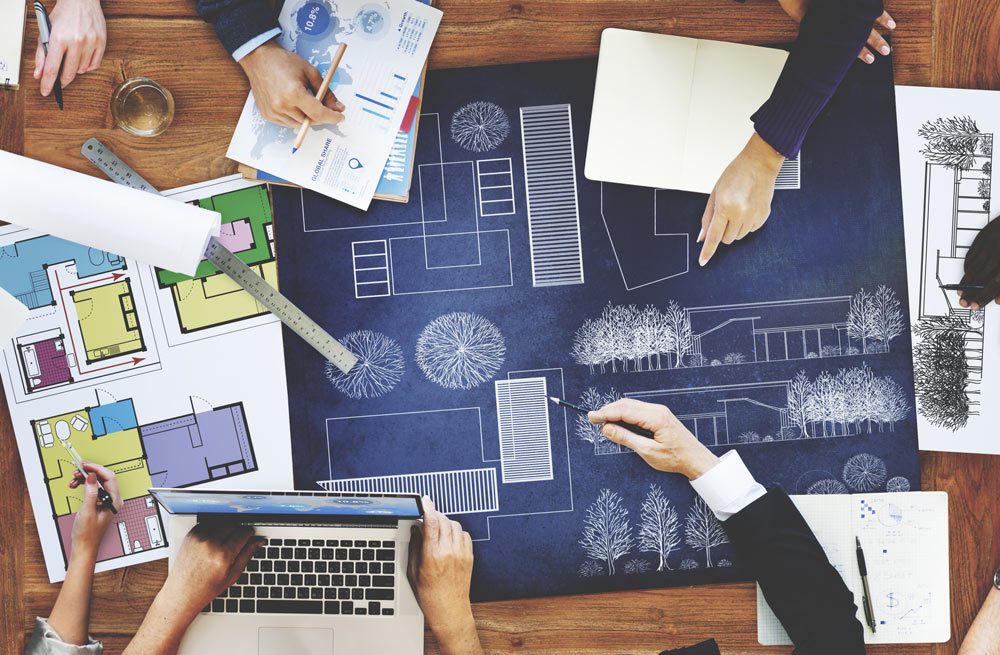Mention the phrase sustainable design and many will likely come up with a list of familiar associations. Solar panels, energy-efficient heating, and cooling systems, tankless water heaters, and efficient insulation are a few features that may come to mind. What most people don’t know is that there is so much more that goes into sustainable building than meets the eye. So buckle your seatbelt. We’re about to geek out on you with the facts!
What Is Meant By Sustainable Building in Construction?
Building sustainably, at its core, recognizes that resources are finite and every part of the building process can be done in a way that makes the most of the resources we have and what is already in use, in a way that makes as little impact on the environment and humanity as possible. Every step that goes into building a custom construction project in Pittsburgh has the potential to be more sustainable.
Eco-conscious architects and builders will use recycled and sustainable resources, utilize energy-saving practices and technology, and minimize energy consumption and the production of waste.
Sustainable design and building practices go well beyond move-in day as well. Through the life of the building or home, it should have the minimal amount of impact on the environment possible. This is where that list of familiar features comes into play, like energy-efficient appliances and solar panels.
So, How Do Sustainable Buildings Help the Environment?
Buildings of any type, be it malls or homes, will produce a lot of CO2. The production of building materials and the construction process creates what’s called embodied carbon, and is responsible for about 20% of annual emissions of CO2 globally. Operational carbon is produced from energy consumption for the rest of the building’s life cycle. This produces 27% of annual emissions.
That’s a whopping 47% of the world’s CO2 emissions every year. The extraction of natural stone, harvesting timber, manufacturing goods into usable products, transporting them, and using the building that’s created are all contributing factors.
Sustainably-built buildings are designed to reduce emissions through a myriad of practices. Whether it’s through renewable resources or innovative carbon-neutral materials, sustainable construction reduces the amount of CO2 escaping into the environment.
What Are Some Examples of Sustainable Building Practices?
Stephanie Blank, Head of CAALA Academy, created a simple graphic (pictured below) that explains what sustainable building actually is compared to what people generally think it is. We’ve narrowed down our explanation to the items that affect homeowners the most.
Renovation of Building Stock
Building stock refers to the buildings and homes that already exist. Remodeling a building or home is far more sustainable than building from the ground up. This is because using fewer materials than a new building reduces embodied carbon. Operational carbon will also be reduced if mechanical systems and other features are replaced with newer, more energy-efficient iterations.
Repurposing And Recycling
During demolition, construction teams can deconstruct a building in a way that preserves materials so they can be recycled and repurposed. Doing this keeps building materials out of landfills and reduces the wasteful production of new materials. Timber, architectural elements, fixtures, windows, doors, millwork, and fencing are all materials that are available through reuse stores that builders, architects, and even individual buyers can access.
During a remodel, the construction team can also reuse materials taken from the same building or homes, such as flooring, timber, bricks, cabinets, hardware, and fixtures.
Efficient Use of Climate Positive Materials
Climate-positive building materials are commonly referred to as green building materials or sustainable building materials. These are materials that may create very little emissions during their production, could absorb carbon during their life in the building, or were made in a way that actually absorbed carbon during their production. A few examples of climate-positive materials include timber, cork, alternative cement, and bamboo.
Social Aspects Along the Production Chain to the User
Sustainable building isn’t only about the material itself but also about the supply chain workers that produce the material. Sustainable supply chains take into account the socially responsible humane practices that affect the safety and security of workers during production.
Consumers are demanding more social sustainability and holding businesses accountable for their operational practices, making socially sustainable materials more readily available.
Fossil-Free and Renewable Energy
Fossil fuels make up about 10% of emissions in the US but many homes still use them to heat water, stay warm, and cook food. Reducing fossil fuels by replacing appliances and equipment that use fossil fuels with electric alternatives is a part of sustainable building in home construction.
Swap out older heating and cooling systems for efficient and effective heat pumps. Replace gas stoves and dryers with electric appliances. Choose a tankless water heater rather than a gas-powered water heater tank. Add in-floor radiant heating to reduce heat loss through forced-air units.
Renewable energy is, by definition, not able to be depleted, making it more affordable than both fossil fuels and electricity. Rooftop solar panels are the most well-known renewable energy source for homes and can come with tax incentives, depending on the location. Solar power can also be used to heat water in place of electric or gas water heaters.
What Are Some Sustainable Building Features Your Pittsburgh Remodeler Could Use in Your Home?
Sustainability During the Design Phase: Reduce, Reuse…Sequester?
Materials that sequester carbon during its production or its lifetime absorb carbon from the atmosphere and trap it, keeping it from being re-released. Some companies are developing alternatives to traditional building materials to be carbon sequesters that are carbon neutral, or even carbon negative.
Concrete, as a carbon-heavy example, produces an enormous amount of emissions during both sourcing and firing. Concrete is recyclable but only about 2% of the material is actually recycled. Concrete producers, however, are experimenting with and producing alternatives.
For example, injecting collected CO2 into concrete mix, using what would traditionally be emitted into the air, reduces production emissions and produces a stronger product. One manufacturer is even using algae-produced calcium carbonate in place of limestone, a main component of concrete, reducing mining and sequestering carbon during its growth.
One of the best carbon sequesters to use in home design is olivine sand. It’s a common mineral that can absorb its own mass in CO2 when ground and used in place of sand in landscaping or as an additive in concrete.
A Tight Envelope
The envelope of a home includes anything that separates the inside of the home from the outside. Windows, doors, roofs, floors, and walls make up a home’s envelope. Creating a tight envelope keeps the home comfortable without expending excess energy by reducing air and moisture leaks. Proper insulation, multi-pane energy-efficient windows, and effectively sealed doors reduce the amount of energy used to heat or cool a home.
Sustainable Design and Construction in Pittsburgh
No matter the region, sustainable design is not only attainable but growing in popularity and affordability. As a Pittsburgh design-build construction and remodeling contractor, Master Remodelers is a certified green design builder that strives to create sustainable homes. Our chief Architectural Designer is particularly well-versed, with 30 years of experience creating designs that are not only exquisite but sustainable. If you’d like to improve the sustainability of your Pittsburgh home, contact Master Remodelers to schedule a consultation.





